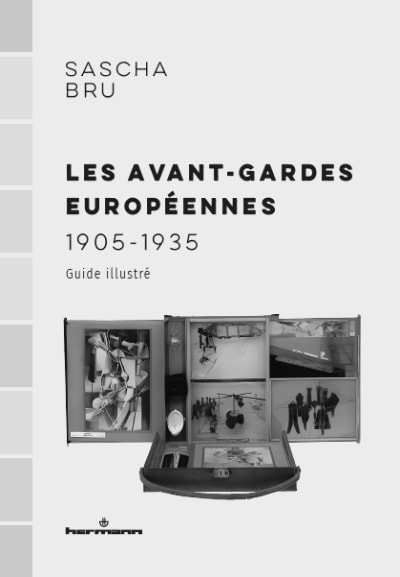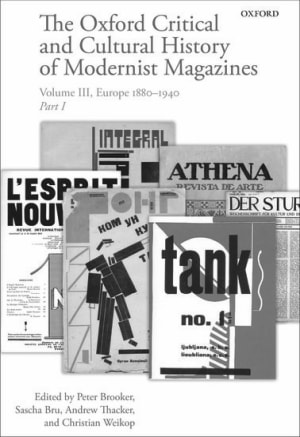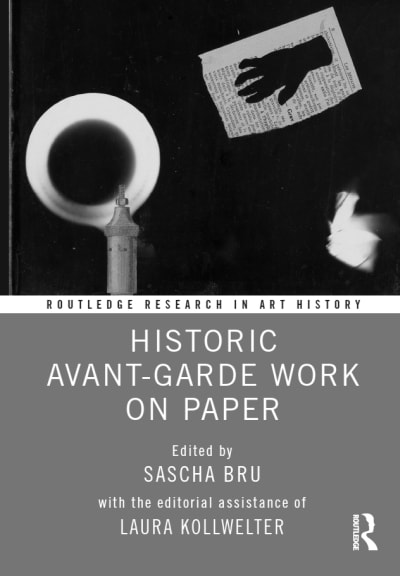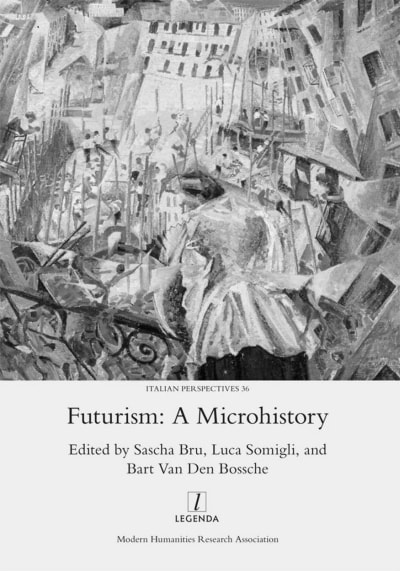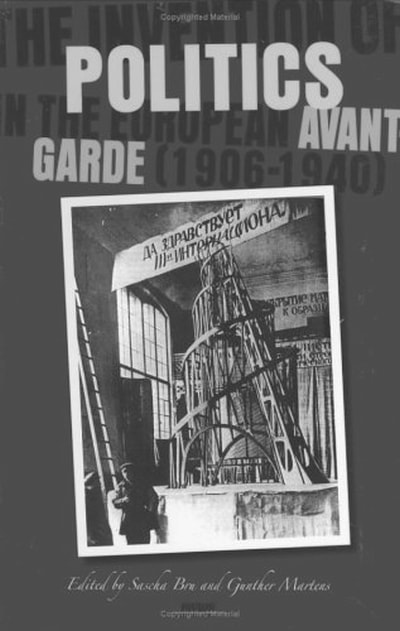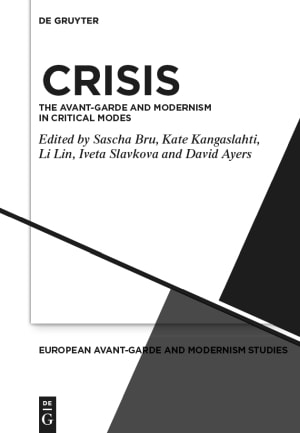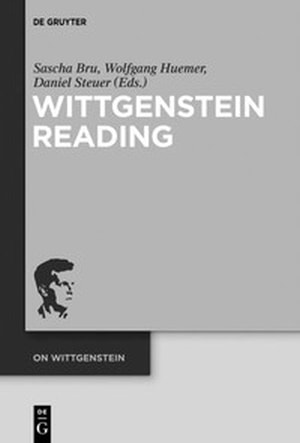Books*
|
2018. Edinburgh University Press (Edinburgh). Hardback & paperback. 272 pages, 76 B&W illustrations, 24 colour plates.
|
The European Avant-Gardes, 1905-1935. A Portable Guide
Structured like a Duchampian boîte-en-valise, this study casts new light on the early twentieth-century avant-gardes (cubism, futurism, expressionism, Dadaism, constructivism and many other –isms) and manifests why they proved such a defining force in the history of the arts, be it the visual or performance arts, architecture or literature. Taking readers on a journey throughout the whole of Europe, from London to Moscow, and beyond, this book sketches the complex cultural, scientific, technological and political contexts with which the avant-gardes interacted. It also discusses the most salient features of the avant-gardes’ work across art forms and media and succinctly surveys major avant-garde movements, which always came in the plural. Clearly written, this book aims to encourage scholars of modernism and of the modern arts to appreciate the astounding breadth and richness of Europe’s now classic avant-gardes. Read more.
"An impressive tour de force … Bru allows his subject – the European avant-gardes – to dictate the methods and approaches, so that this book genuinely embodies a rigorous, and far from capricious, pluralism." Andreas Kramer (Goldsmiths, University of London), Arcadia
“With the most impressive yet lightly-worn erudition … it is, above all, an extremely carefully-structured book ... informative, enjoyable, lively, a good companion, reliable and, indeed, portable; in short, well worth a detour to buy a copy.” David Cottington (Kingston University of London), Konsthistorisk Tidskrift/Journal of Art History "Highly readable, consistently informative, and, it should be said, unerringly successful … I cannot imagine a reader of this book who will not learn a considerable amount about the field under consideration, and I cannot imagine a writer better than Bru, whose career to date has been steeped in a critical exposition of the avant-garde, to guide us through this … always arresting field of inquiry." Robert Brazeau (University of Alberta), The Modernist Review |
”This 'portable guide' — succinct but never superficial, precise but never pedantic, may well be the one indispensable book on the European Avant-Garde movements. Bru’s concluding speculations on the future of the avant-garde and its various theorists is especially welcome. A brilliant study!" Marjorie Perloff (Stanford University)
“Modernism is associated with an ‘institutional colossus’ like the Museum of Modern Art (MoMA) in New York, dubbed ‘Modernism Central’ by Hal Foster … It stands for something remote and critically fossilized; a topic to be treated with disdain or at best ironic indifference … Bru wanders freely across a dizzying array of disciplinary boundaries and geographical borders … and provides a very different account of the modernist avant-garde … which he calls a significant ‘counterforce in cultural history’ … [This is] avant-garde studies after modernism." Andrew McNamara (Queensland University of Technology), Art History "A high quality, high level and multi-faceted discussion of early 20th-century art." Natalie Adamson (University of St Andrews) “By paying attention to the political dimension of the avant-garde, this book yields a multifaceted image and by foregrounding the role of women in the patriarchal avant-garde it sketches a more ambivalent picture than that encountered in research so far.” Janka Wagner (University of Oldenburg), Spiegel der Letteren "This book has every prospect of becoming the founding and defining pedagogic platform for avant-garde studies." Jed Rasula (University of Georgia, Athens)
|
|
2009. Edinburgh University Press (Edinburgh).
Hardback, 264 pages, 7 B&W illustrations. |
Democracy, Law, and the Modernist Avant-Gardes. Writing in the State of Exception
This book studies the ties between the avant-gardes and democracy in Europe. Focusing on the nineteen-tens and twenties, it brings together a wide range of experimental writers. The book locates these writers within their exceptional democratic contexts and demonstrates how the modernist avant-garde, during the First World War and the upheavals that followed, found itself caught up in a series of 'states of exception'. In such states legal democratic institutions were bracketed and set aside, and 'literature' as a relatively autonomous realm was temporarily suspended. Faced with extreme forms of politicisation, avant-gardists throughout Europe tried to safeguard literature's autonomy in a variety of ways. These included turning politics and law into genuinely artistic materials and producing a repertoire of alternatives to existent frameworks of democracy. Against assertions that anti-art avant-garde gestures were meant to overcome art's autonomy and approximate the condition of politics, this book shows that European avant-gardists may well have been one of the staunchest defenders of art's sovereignty in modern times. Read More.
|
"Bru convincingly shows that only a radical change in methodology will allow scholars to unpack the full potential of literary work created in this period defined by fluidity and uncertainty." Harold Williford (New York University), NYU Journal of International Law and Politics
"This shrewd and careful analysis of politics and avant-gardism [demonstrates how] the instability of democratic arrangements in the time made the border between politics and art permeable and encouraged new, dramatic, experimental kinds of cultural-political intervention." Ken Hirschkop (University of Waterloo), Linguistic Turns, 1890-1950 "Penetrating deep into a world which for most students of Anglo-American modernism will be as intriguing as it is unfamiliar, Sascha Bru's new study invites a fundamental rethinking of our notions of modernist avant-gardism and its political ambitions." Peter Nicholls (New York University) |
|
This two-tome book contains fifty-six original essays on the role of 'little magazines' and independent periodicals in Europe in the period 1880-1940. The book demonstrates how these publications were instrumental in founding and advancing developments in European modernisms and the avant-gardes. Its expert discussion of approaching 300 magazines, accompanied by an illuminating variety of cover images, from France, Italy, Germany, Spain and Portugal, Scandinavia, Central and Eastern Europe extend and strengthen the understanding of modernism, avant-gardism and modernity. The chapters combine to elucidate the part played by magazines in the broader formations associated with Symbolism, Expressionism, Futurism, Dada, Surrealism, and Constructivism in a period of fundamental social and geopolitical change. Read more.
Ed. with Peter Brooker, Andrew Thacker and Christian Weikop.
2013. Oxford University Press (Oxford). Hardback, 2 tomes,1528 pages, numerous B&W halftones. Paperback edition 2016. “Anyone working in modernist studies must record their gratitude for the herculean editorial labor that has gone into this 1,500-page volume—a gateway to further studies in this field.” Jason Harding (Durham University), Modernism/Modernity
"As a reference book, it could hardly be improved." Marjorie Perloff (Stanford University), Times Literary Supplement Read a review-essay in the London Review of Books here. |
This book examines the many functions of paper in the art and aesthetics of the early twentieth-century modernist or historic avant-garde (expressionism, cubism, futurism, Dadaism, surrealism, constructivism and many more). With its many collages and photomontages, the historic avant-garde is generally considered to have transformed paper from a mere support into an artistic medium and to have assisted in art on paper gaining a firm autonomy. Bringing together an international team of scholars, this book shows that the story of paper in the avant-garde has thereby hardly been told. Reconsidering the work on paper of canonized avant-gardists, from Pablo Picasso, Marcel Duchamp, Hans Arp and Joan Miró to Bruno Taut, Sergei Eisenstein, Aleksandr Rodchenko and beyond, this book canvasses the many uses of paper in the avant-garde. Besides demonstrating that it was perhaps above all on paper that the international formation of the avant-garde gained shape, the book also explores how the avant-garde’s attentiveness to paper almost always implied a critique of the ways in which paper, and all that it stood for, was treated and labored in European culture and society more broadly. A book of interest to scholars working in art history, modernism, and design. Read more.
Edited with the assistance of Laura Kollwelter.
2024. Routledge (New York and London). Hardback, 262 pages. 89 colour illustrations. |
This book presents a microhistory or ‘history from below’ of Italian futurism, one of Europe’s most famous avant-garde movements. Microhistory, the idea for which partly arose in Italy with the work of Giovanni Levi and Carlo Ginzburg, is the intensive historical investigation of a well-defined smaller unit of research (most often an event, an object, a small community or a village). Microhistory explores large questions in small places. Applying this perspective to the study of Italian futurism, this book casts new light on the work of eminent futurists such as F.T. Marinetti, Umberto Boccioni and Antonio Sant’Elia, while further highlighting the unexpected significance of beds, playing football and letterheads to the more general development of the avant-garde movement. Read more.
Edited with Luca Somigli and Bart Van den Bossche.
2015. Legenda (Oxford). Hardback, 260 pages, 40 B&W illustrations. Paperback edition 2017. “The chapter structure is cleverly designed to replicate a ‘day in the life’ of a Futurist ‘new man’, with chapters focusing on places both large and small from ‘The Skyscraper’ to ‘The Bed’... This book was a pleasure to read and will reward both the serious scholar of Futurism and the more casual reader of twentieth-century Italian culture who may wish to dip in and out of the Futurist day.” Selena Daly (Royal Holloway, University of London), Modern Language Review “Essential reading for every scholar of the avant-garde.” Stefano Bragato (University of Zürich), Italian Studies |
|
In 1906, for the first time in his life, F.T. Marinetti connected the term ‘avant-garde’ with the idea of the future, thus paving the way for what is now commonly called the ‘modernist’ or ‘historical avant-garde’. Since 1906 the ties between the early twentieth-century European aesthetic vanguard and politics have been a matter of debate. With a century gone by, The Invention of Politics in the European Avant-Garde takes stock of this debate. Opening with a critical introduction to the vast research archive on the subject, this book proposes to view the avant-garde as a political force in its own right that may have produced solutions to problems irresolvable within its democratic political constellation. In a series of essays that combine close readings of texts and art works with a thorough knowledge of their political context, the book looks at avant-garde works from futurism, expressionism, dadaism and surrealism as media producing political thought and experience. Read more.
Edited with Gunther Martens.
2006. Brill (Leiden). Hardback, 290 pages, 11 B&W plates. “Passionate, rich, and varied … an original, interesting, and substantial contribution to the field of modernism and avant-garde studies.” Simona Storchi (Swansea University), Modern Language Review
“Well-worth reading for all who are interested in the history of ideas and artistic evolution(s).” Eleni Karasavvidou (Aristotle University, Greece), The European Legacy Realisms of the Avant-Garde
This collection of essays examines the intricate relationship between realism and the avant-gardes in their international context from the late nineteenth century up to the present day. Read more.
Edited with Moritz Baßler et al.
2020. de Gruyter (Berlin). Hardback, 620 pages, numerous B&W and colour images. Beyond Given Knowledge
This book investigates the nineteenth and twentieth-century avant-gardes' efforts to go beyond given knowledge in art, science, politics and metaphysics. Read more.
Edited with Harri Veivo et al. 2018. de Gruyter (Berlin). Hardback, 412 pages, 16 colour illustrations. |
Notions of crisis have long charged the study of the European avant-garde and modernism, reflecting the often turbulent nature of their development. Throughout their history, the avant-garde and modernists have both confronted and instigated crises, be they economic or political, aesthetic or philosophical, collective or individual, local or global, short or perennial. This book addresses the myriad ways in which the avant-garde and modernism have responded and related to crisis from the late nineteenth to the twenty-first century. How have Europe’s avant-garde and modernist movements given aesthetic shape to their crisis-laden trajectory? Given the many different watershed moments the avant-garde and modernism have faced over the centuries, what common threads link the critical points of their development? Alternatively, what kinds of crises have their experimental practices and critical modes yielded? The volume assembles case studies reflecting upon these questions and more from across all areas of avant-garde and modernist activity, including visual art, literature, music, architecture, photography, theatre, performance, curatorial practice, fashion and design. Read more.
Edited with Kate Kangaslahti, Li Lin et al.
2022. de Gruyter (Berlin). Hardback, 580 pages, 30 B&W and 50 colour illustrations. While artists and writers from Rosemary Waldrop and Joseph Kosuth to Steve Reich have not shied away from engaging with Ludwig Wittgenstein, scholars often remain resistant to engage seriously with the literary inflection of his philosophy. This book brings a concise yet near complete picture of Wittgenstein’s view of literature. It offers a representative sample of authors Wittgenstein read, combining the famous and to be expected (Shakespeare, Milton, Goethe, Schiller, Tolstoy, Trakl, Dostoyevsky, etc.) with names that have received far less attention in Wittgenstein scholarship (Kleist, Lessing, Lewis Carroll, Busch). Many, if not all, of the contributions, from a variety of angles, approach the moment of literature as a vehicle of self-reflection for Wittgenstein. Read more.
Edited with Wolfgang Huemer and Daniel Steuer.
2013. de Gruyter (Berlin). Hardback, 414 pages, 20 B&W illustrations. |
Europa! Europa? The Avant-Garde, Modernism, and the Fate of a Continent
This book focuses on the relation between the avant-gardes, modernisms and Europe. The essays collected here bring out the complexity of the European avant-gardes and modernisms by relating them to Europe’s intricate history, multiculturalism and multilingualism. They inquire into the divergent cultural views on Europe taking shape in avant-gardist and modernist practices and chart a composite image of the “other Europe(s)” to have emerged from the avant-gardes and experimental modernisms. How did these aesthetic formations in (and outside) Europe give shape to local, national and pan-European forms of identity and community? And to what extent does the well-rehearsed claim that the avant-gardes originally formed a typically European phenomenon hold true? Read more.
Edited with Tania Ørum et al. 2009. de Gruyter (Berlin). Hardback, xii, 534 pages, 37 B&W illustrations. Regarding the Popular
Regarding the Popular explores the complex relationship between the avant-gardes and modernisms on the one hand and popular culture on the other. Covering ‘historical’ avant-gardists, neo-avant-gardists and modernists from various European countries, the volume's essays investigate the nature of so-called ‘low’ culture, dealing with aspects as diverse as the everyday and folklore. Regarding the Popular canvasses the many ways in which the allegedly ‘high’ modernists and avant-gardists looked at and represented the 'low'. The collection covers experimental architecture, music, dance, literature, film and painting . Read more.
Edited with Laurence van Nuijs, Benedikt Hjartarson et al. 2011. de Gruyter (Berlin). Hardback, xii, 487 pages, 77 B&W illustrations. The Aesthetics of Matter
The arrival of the early twentieth-century avant-gardes coincided with an in-depth exploration of the materiality of art and writing. The avant-gardes excelled in their attempts to establish the specificity of media and art forms as well as in experimenting with the hybridity of the materials of their multiple disciplines. The Aesthetics of Matter sheds light on the range and import of this aspect in avant-garde aesthetics across all art forms and throughout the nineteenth and twentieth centuries. Read more.
Edited with Sarah Posman, Anne Reverseau et al. 2013. de Gruyter (Berlin). Hardback, xii, 435 pages, 72 B&W illustrations. |
Essays*
|
Reading Roche: Rough Reading
Textual Practice, forthcoming. CoBrA: Vital Manifestation Éva Forgács, ed. Between Point Zero and the Iron Curtain: International Cooperation in Art and the Postwar Moment, 1945-1948 (Leiden: Brill, 2024), forthcoming (with Éva Forgács). Avant-Garde Egypt Journal of Avant-Garde Studies, 4:1 (2024), 1-12. Revolution Reconsidered: The Three Avant-Garde Traditions Polona Tratnik, ed. European Avant-Garde: A Hundred Years Later (Leiden: Brill, 2023), 15-44. Making Psychoanalysis New: Freud, Print Culture, and Modernism Modernism/modernity, 30:2 (2023), 397-419 (with Peter Buse). |
Time Assemblage
Jean-Michel Rabaté et al., eds. Historical Modernisms: Time, History and Modernist Aesthetics (London: Bloomsbury Academic, 2022), 141-57. René Magritte, Illustrator during the Second World War Ex Officina: Stories from the Stacks of KU Leuven Libraries (2022), 15. The Avant-Garde Monument: A New Architecture of Memory Journal of Avant-Garde Studies, 1:1 (2021), 42-69. Chiara Bugatti’s Brute Force, or, How to Rehearse a Monument Site Zones (2021). Red Rosa: On the Gender of the November Revolution in the German Avant-Gardes Modernism/modernity, 24:3 (2017), 461-83 (with Anke Gilleir). Lewis and the European Avant-Gardes Tyrus Miller, ed. The Cambridge Companion to Wyndham Lewis (Cambridge: Cambridge University Press, 2016), 19-31. A Centrifugal Reading of De Stijl's Constructivist Poetics: On Cendrars, Vantongerloo, Mondrian, Doesburg, and Moholy-Nagy JDL, 7:1 (2016), 43-58 (with Tom Willaert). Politics as the Art of the Impossible: The Heteronomy of Italian Futurist Art-Action Aleš Erjavec, ed. Aesthetic Revolutions and Twentieth Century Avant-Garde Movements (Durham, NC: Duke University Press, 2015), 19-41. 'Sagen': Brecht's Aesthetic of Public Address Affirmations: of the modern, 3:1 (2015), 9-31 (with Anke Gilleir). |
The Genealogy-Complex. History Beyond the Avant-Garde Myth of Originality
Filozofski Vestnik, 35:2 (2014), 13-28. Paul van Ostaijen's 'User's Guide to Lyric' Chicago Review, 58:2 (2014), 90-102 (with Tom Willaert). Avant-Garde Nows: Presentist Reconfigurations of Public Time Modernist Cultures, 8:2 (2013), 272-87. Opera, Allegory, Remembrance: Auden's and Stravinsky's The Rake's Progress TSLL, 55:1 (2013), 86-99. The Untameables: Language and Politics in Gramsci and Marinetti Elza Adamowicz, et al., eds. Back to the Futurists. The Avant-Garde and Its Legacy (Manchester: Manchester University Press, 2013), 243-54. A History of Aristocracies L'Esprit Créateur, 53:3 (2013), 64-78 (with Bart Van Den Bossche). Modernism Before and After Theory Peter Brooker et al., eds. The Oxford Handbook of Modernisms (Oxford: Oxford University Press, 2010), 59-78. A Map of Possible Paths: Modernism After Marxism Astradur Eysteinsson at al., eds. Modernism, 2 vols. (Amsterdam: John Benjamins, 2007), vol. 1, 107-24. Kind of Magic: World Construction in French Surrealism and Belgian Magical Realism Alexander Graf, et al., eds. Avant-Garde Film (Amsterdam: Rodopi, 2007), 231-48 (with Bart Keunen). Dada as Politics Arcadia, 41:2 (2006), 296-312. |
* This page presents a selection of (book) publications. For a more comprehensive bibliography, click here.

